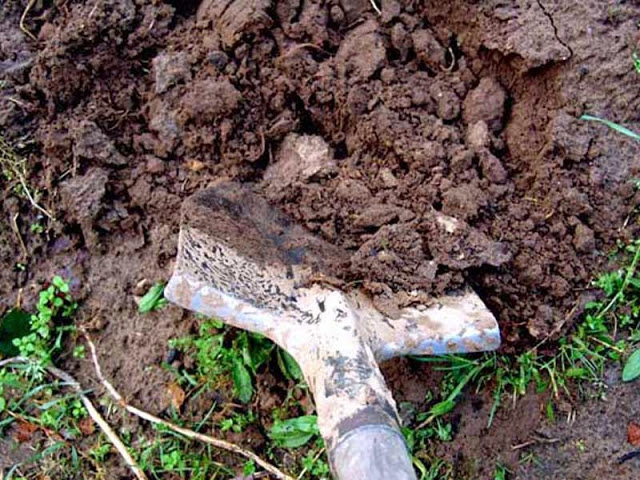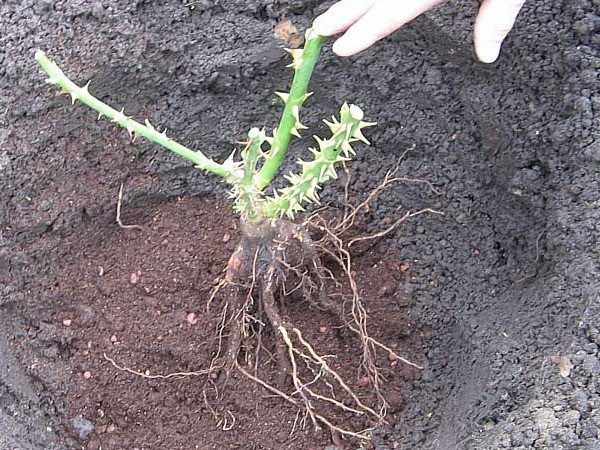Transplanting roses in the fall. Instructions on how to replant a large or old rose. Time to plant seedlings.
Roses are one of the most popular garden plants. It's rare to see the owner country house, who refused to decorate the garden in this way. But in order for these flowers to delight owners and guests with their beauty and fragrance, you need to know when to replant roses so that this plant grows well, takes root and gives its magnificent blooms to others. Often the difficulties of growing this crop are associated with transplanting roses. Inexperienced gardeners do not pay attention this issue due attention, and the result is bushes that are not able to take root in a new place, do not tolerate changes in climatic conditions and have poor resistance to garden diseases. To avoid such problems, you need to consider the rules for caring and planting roses and adhere to them.
Replanting roses can be caused by many reasons:
- Redevelopment of a personal plot. It is not always possible to immediately plan the placement of objects on the site, or over time the need for additional construction arises, then ready-made elements of landscape design, such as, have to be shifted or even moved.
- Unfavorable neighborhood . In some cases, planted rose bushes begin to suffer from external factors that cannot be protected or eliminated. So after planting, it may turn out that this area is flooded, overly shaded, or adjacent to plants that conflict with roses. Because of this placement, plants often get sick, weaken and may even die.
- Bad . Sometimes, due to loose sandy loam soil, the root system of a plant can deepen beyond measure, which causes rotting and disease of the flower. And with clay soil, the bushes come to the surface excessively, which causes the roots to dry out and dry out. In addition, old flower beds may become depleted of soil, causing a lack of necessary elements for the formation and growth of flowers.

- Bad conditions. Poor growth, lack of flowering, drying out of buds and dying off of shoots often indicate that the necessary conditions for the quality growth and development of a flowering plant are not met.
- Bush growth. If you properly care for garden roses, sooner or later the bushes will grow to a huge size, but at the same time they will lose all their decorative effect and clutter the area with impenetrable thickets.
The solution to all of the above problems can be replanting garden trees. But in order not to destroy the plant and do all the work correctly, you need to have considerable experience, or you can use the experience of generations and simple rules planting bushes in a new place.
Choosing a place for a rose garden
To grow roses, it is extremely important to choose the right place so that replanting is not required due to bad conditions. Of course, you can experiment, but it’s better to think about the place for the future once and enjoy the result.
Mandatory conditions that will ensure normal growth and full development of a flower bed with roses include:

- Illumination. Roses need a lot of light for intensive growth and spectacular flowering, so you should study personal plot in order to identify the area where most day the sun's rays hit. The shadow from buildings and trees, which will cover the bushes from the sun, will negatively affect the flowering process, so the place for the rose garden should be in a lighted area.
- Protection from winds. Strong or constant winds can disrupt the harmony of flowering flower beds, so it is worth considering the location in such a way that the plants are protected from aggressive weathering. Trees, ornamental shrubs and garden barriers will help you cope with the task perfectly. Such placement of flowers will ensure active summer flowering and provide protection from winter blizzards.
- Humidity. The location at the foot of the slopes or in the lowlands will contribute to the accumulation of excess water in the soil, which negatively affects root system roses and causes rotting, and in autumn and winter – freezing.

- Soil composition. The presence of clay and mineral-rich soil is a plus for growing roses. But if the site does not meet the soil requirements, then you can get specialized soil for the flowerbed and replenish it in a timely manner.
It is best to choose a place for a future flower bed in the fall. This way you can evaluate all the advantages and disadvantages of the site and choose the optimal place for roses.
If all the work is carried out correctly and all possible external factors are taken into account, then no more transplantation will be needed, and a well-formed one will delight you for many years. For optimal effect, you need to adhere to the basic rules of planting old bushes in a new place:
- Time. The optimal period for transplanting a mature bush into new conditions is early spring or mid-autumn. If the autumn period is chosen, then you need to choose the time 3-4 weeks before the onset of cold weather, so the plant will have the opportunity to take root and overwinter without loss. If the transplant takes place in the spring, then the work should be done in the evening or wait for cloudy weather, so the root system will have a period of adaptation to the new place and will take root faster.
![]()
- Preparing the site. When planting bushes in place of a dead plant, it is necessary to thoroughly clean the soil of old soil and remnants of the roots of its predecessor. The optimal solution would be to fill the hole with a new soil mixture with garden fertilizer for roses. It is necessary to replace the soil not only under the new seedling, but also within a radius of 30 cm from it, this will provide space for growth.
- Preparing the plant. Before replanting in the fall, old bushes must be trimmed, dried shoots, foliage and excess branches removed. If you are replanting an overgrown plant, you can remove part of the root system, so the old bush will be renewed, and the removed part will be able to take root in a new place.
- Digging up a bush. To remove a bush from the ground, you need to know what type of plant grows on the site: self-rooted roses or grafted ones. A rooted flower is characterized by a superficial location of the rhizome, while grafted species are characterized by a developed buried root system. Taking into account the location of the root, it is necessary to carefully dig up the plant so that the root covers part of the soil. The earth ball will help to avoid unnecessary injury to the plant, but if part of the rhizome is damaged, then with proper care, it will quickly recover, without damage to the plant.

- Transfer to a new location. To prevent thin root shoots from coming off with the ground, it is necessary to wrap the earthen lump in cloth or paper, in which the old flower will be transferred to a new planting site. This solution will help avoid additional injuries and stress for the seedling. Planting in a new location is done without removing paper or fabric. These materials will not interfere with root growth and will be quickly recycled.
- Preparing for transplantation. The new location must begin to be prepared several weeks in advance. The dimensions of the hole should be slightly larger than the volume of the dug earthen ball. A week before planting, compost fertilizer is added to the hole and dug into the main soil. And a couple of days before planting, another layer of soil is added to avoid direct contact of the fertilizer with the root system, which can cause burns.

- Transplantation process. Before moving the plant, you need to water the prepared hole generously. Afterwards, the wrapped rhizome with old soil is transferred to a new hole and covered with a new earthen mixture. For a rooted flower, the roots are positioned so that the top coincides with the natural ground level. And for grafted species, the root is immersed 5 cm below ground level. After planting, it is necessary to lightly compact the fresh soil and water the bush generously.
If all the work is done correctly, you can be sure that the plant will take root successfully and the result will be noticeable in the next season.
But such experiments with landscape design of a site should not be carried out more often than once every 3-5 years. In a shorter period, the flowers will not be able to adapt and form into a full-fledged plant, which, under external stress, can lead to the death of the seedlings.
Growing in a new place
If planting is done in a flowerbed with already formed roses, it is necessary to fulfill some conditions that will help the new plant more easily adapt to its neighborhood and environment:
- varieties should approximately coincide in flowering time, so fast-growing neighbors will not dominate and interfere with the growth of the new neighbor;
- if planting occurs in the fall, then neighboring bushes can also be pruned;
![]()
- Watering and feeding the entire flowerbed must be done simultaneously, this helps stimulate the same growth rate of the rose garden.
To ensure optimal rooting of the rose, you can prune new shoots for the first one or two seasons without allowing the plant to bloom. Similar measures should be taken for neighboring bushes, creating uniform conditions for formation.
In order for a newly planted bush to successfully overwinter, you must remember to cover the roots before the onset of cold weather. To cover, you need to loosen the soil, remove all young shoots and leaves using pruning shears and cover the bush with wintering material. For high-quality protection from frost, spruce branches, spruce sawdust or specialized synthetic material are perfect. (No votes yet)
Roses are considered rather capricious flowers, but this does not mean that dust particles should be blown off them and under no circumstances should they be replanted. If such a need arises, then even an adult plant can be moved to another place. But you should take into account some rules.
When is the best time to replant roses?
The most suitable time to transplant roses to another place is early spring and early autumn (from late August to mid-September). It is better not to carry out this procedure in late autumn, since a rose that is not yet strong after transplantation may not survive the winter well.
If you have no other choice, you can transplant the rose from place to place in the summer (always in cloudy weather). But in this case you will have to prune the bush heavily. If the plant is quite tall, then you need to shorten the shoots to 40-50 cm, and remove old ones completely. When replanting a small bush, you only need to trim young immature shoots.
Instructions on how to replant a large or old rose
The conditions for growing roses in a new place should be as close as possible to the previous ones so that the plant experiences less stress. A rose's new habitat may differ only if the current one is absolutely unsuitable for it. But the site must be protected from the wind. And keep in mind that roses do not like deep shade and soil in which moisture stagnates.
Prepare the planting hole thoroughly: remove all weed roots, place drainage at the bottom, fill the hole with fertile soil (you can add compost) and leave for 2-3 weeks so that the soil settles a little. After this, start digging up the bush.
Try to dig up the rose according to the projection of the crown - with the largest possible lump of earth. To make this easier, first thoroughly water the soil under the bush. Then the earth will crumble less. To make it easier to approach a spreading plant, tie its shoots with a tight rope.
Dig a trench around the perimeter of the bush and gradually deepen it until you get a fairly deep ditch. Then tie the earthen ball with any fabric or plastic wrap and continue digging under the base of the bush. If the plant’s roots are too long and prevent you from reaching the earthen ball, chop them off with a sharp shovel blade. With proper care in a new place, they will quickly recover. Just before planting, it is advisable to sprinkle the cut areas with charcoal. If the bush is very large, place a strong and fairly long object (for example, a crowbar) under its base and, using it as a lever, pull out the plant. Carefully place the bush on the previously spread fabric and drag it to a new location. To prevent the earthen ball from falling apart, tie it with twine.

Remember that if the rose is to move far away (for example, to another area), then the earthen lump needs to be wrapped in damp burlap so that the roots do not dry out.
Place the rose in the planting hole so that the bush covered with earth is at the same level as it was in its previous place. Remove the tie from the ball after filling half the hole with soil. Then water the soil, wait for it to soak in, and then fill the planting hole to the brim and water again. If the soil has settled, add a little soil so that there are no air voids left around the roots of the rose.
This method is suitable if you are looking for an answer to the question of how to transplant a tea rose, as well as any bush form.
In the first month after transplantation, the plant needs to be watered regularly, but moderately, and shaded during bright sunshine. In spring and summer, daily spraying of the crown is also recommended. After transplanting roses, it is not advisable to disturb them for several years so that they adapt to their new habitat.
How to replant a blooming rose?
If you want to replant a rose during flowering, then this year you will have to sacrifice beauty, since all flowers and buds must be removed from the bush. This is necessary so that the rose takes root well in a new place and directs all its efforts to restoring the root system, and not to the formation of flowers.
In addition, you need to treat the roots with special care and try to minimally injure them, while it is advisable to preserve even long roots. Otherwise, the transplant technology does not differ from that described above.
How to transplant a climbing and climbing rose?
When transplanting these plants, you also need to take into account some features. The first step is to remove the shoots from the support. Ramblers retain all the shoots of the current year, and at the end of August (if transplantation is carried out in the spring), their tops are pinched so that the branches become woody. Remove shoots older than two years completely immediately after flowering.
Remember that when transplanting climbing plants, it is better to shorten all long shoots by 1/2 or 1/3, otherwise it will be difficult for you to transport the plant to another place.
There can be several reasons for replanting roses: changing the design of the site, planting an overgrown rose garden, transferring a variety you like from a neighbor to yourself.
Whatever the circumstances, when transplanting rose bushes you need to take into account some nuances:
- It is important to choose the right place for the rose: it does not like shade, stagnant moisture, or proximity to certain types of plants.
- It is necessary to properly prepare the bush for replanting and prepare a hole in advance.
- When digging up a bush, you need to remember that the root system of a rose has approximately the same diameter as the crown, so you need to try not to damage the roots when digging and transporting.
- You need to know when is the best time to replant roses in the garden.
Let's talk about the last point in more detail. The survival rate and further normal development of the plant largely depends on compliance with the temporary transplantation rules.
What time of year is it best to replant mature roses?
According to the rules, best time The best time to transplant roses is in autumn or early spring. Moreover, there are advantages to both autumn and spring replanting. You can choose for yourself when it is better to replant roses - in spring or autumn, depending on the possibilities and conditions.
When is the best time to replant roses in spring?
If you decide to do this work in the spring, this may be either a time when the danger of frost has passed and there is no need for shelter, or an earlier period. If you replant roses not in early spring, but after the end of frost, this can lead to the bushes becoming  under bright sun and will suffer from dry soil.
under bright sun and will suffer from dry soil.
To prevent this, they need to be watered on time. But under such conditions they quickly grow, take root easily and develop well. And so that the sun does not immediately burn the rose, you must first cover it with spruce branches. This planting method is especially relevant in cold regions.
When is the best time to replant roses in the fall?
Experienced gardeners still prefer to transplant roses in autumn. The main advantage of this method is that the rose will have time to take root and harden, and as a result, they will be less susceptible.
The best autumn period for replanting rose bushes is September 15 - October 20. At this time, the air temperature is still quite high, so the bushes have time to take root before the onset of frost. When the time of cold weather comes and the temperature drops sharply at night, the plants need to be covered.
The rose has long been the most revered flower in all countries of the world. Charming beauty, thanks to the rich color scheme and divine aroma, has always occupied a special place as a decoration for any home, palace or temple. It became the most indispensable attribute of any celebration. And, undoubtedly, the rose occupies a special place in flower beds. When is the best time to replant roses? The answer to this question can be found in this article.
Of course, such divine beauty requires special attention. Rose lovers need to know everything about plant care. But it's not just about caring for her. all year round, but also about the correct landing or transfer from place to place.
When is the best time to replant a rose?
The most suitable time for transplantation is spring or autumn. In spring - from the moment the ground completely defrosts after winter, until the buds open, and in autumn - from early September to mid-October. If necessary, you can replant the rose in the summer, but you must adhere to certain rules: maximum preservation of the earthen coma, rainy or cloudy weather, partial pruning, and also creating shade for the transplanted bush.
Latest articles about gardening
Reasons why you have to replant roses
Sometimes it is necessary to change the location of perennials in a flower garden; a variety of reasons can prompt a gardener to make such a decision:
- there was a need to redevelop the site;
- flooding of bushes with groundwater or shading by neighboring plants (buildings);
- the root system of the bush deepening over time if the rose is planted in loose sandy loam soil;
- excessive exposure of the root system to the soil surface (clay soil pushes them out);
- there is no flowering in the same place, the buds dry out, the shoots die off;
- loss of decorativeness of the bush due to growth;
- the soil under the bushes is depleted or its composition is not suitable for flowers, other reasons.
Transplanting roses in the spring to a new place should be caused by a serious reason, and not just a whim of the owner, because the flower will be subject to severe stress. Flowering bushes cannot be replanted; they may die without ever recovering from the forced change of location. Spring replanting, before buds appear on the shoots, is preferable: the bush will have enough strength and time to restore the root system, and in the summer the rose will grow luxuriantly.
Preparing a hole for transplanting a rose to another place in the spring
They begin preparing the planting hole three weeks before the intended transplant. The dimensions of the new planting hole should be no less than the hole from which the rose bush was dug. The average diameter of the hole is approximately 60 cm, depth - 45 cm. Loosen the bottom of the hole and fill it with soil mixed with compost, and cover it with regular soil on top so as not to burn the roots of the roses. Before planting the rose, water the hole well. 
Preparing the bush for replanting in the spring to another place
Having noticed the width of the crown of the rose chosen for transplantation, it is tied tightly so that the branches of the bush do not interfere with the work. To form a dense lump of earth around the roots, the plant is watered abundantly.
When the water is absorbed and compacts the soil, you can begin to dig in the bush around the previously planned root area. Grafted roses have a central taproot that extends deep into the ground.
Such a root will simply have to be cut off. Ungrafted bushes are characterized by a superficial location of the root system, so this problem will not arise with them.
When a trench around the bush has been dug to a depth of 30–40 cm, you can remove the plant and lay it, along with a lump of earth, on previously prepared rags.
If the bush and the corresponding lump of earth are very large, tying with rags can be done as you dig a trench, carefully laying the fabric around the bush and, having secured the ground well with the material, remove the rose from the ground.
If the place where the rose is to be transplanted is far away and transporting the bush will take long time, the fabric holding the earthen ball must be regularly moistened by spraying.
Planting roses in a different place in spring
The grafted rose is placed in the planting hole so that the root collar is about five centimeters below ground level. For a rooted rose, the lump of earth with roots should be level with the surface of the earth. Cover the installed plant with garden soil, lightly tamp it down and water it generously.
The classic way to transplant roses to another place in the spring
It is best to replant roses in this way if it was not possible to preserve the earthen ball. Then, it is worth carefully examining the roots, assessing the damage, and, if the bush is still young enough, then trim off the underdeveloped and damaged ones. After this, the roots should be soaked in a solution of humate, a root-forming growth stimulator, for 2 hours.
A hill is made at the bottom of a pre-prepared hole, along which the rose roots will be evenly distributed. In this case, it is important that the grafting site is 3-5 cm below the soil level. Water is poured into the hole, then a layer of soil is poured up to approximately half of the recess and compacted well. After this you will need to water again. Now the hole is completely buried after the water has been absorbed. The soil should be compacted well again so that no air remains between the roots. 
Wet method of transplanting roses to another place in the spring
This method is very simple and convenient. Water is poured into the hole (a bucket, but more is possible), and while it is not yet absorbed, humate or a heteroauxin tablet is added. And immediately, the roots of the rose bush are placed in the water along with a lump of earth. More water is added. Now you need to wait until the water is absorbed, gradually dissolving the soil and deepening the roots of the plant along with it. Then the hole is buried and compacted well. It would be good to use mulch to prevent the soil from drying out 
Transplanting a bush rose to another place in the spring
To replant a bush rose, you should prepare planting holes with a diameter of 50-60 cm and a depth of 50-70 cm about a month before work. It is recommended to fill the bottom with compost or a small amount of mineral fertilizers mixed with fertile soil.
Transplantation technology:
- It is very important to shed the soil in the planting hole generously with warm water with the addition of a small amount of potassium permanganate crystals;
- the grafted plant should be placed in a planting hole with the root collar deepened by approximately 5-6 cm;
- the rooted plant should be placed without burial, at the same level with the soil surface;
- the root system should be placed as carefully as possible in the planting hole and carefully sprinkled with garden soil;
- After planting, the soil around the bush must be thoroughly compacted and watered with warm water with the addition of complex mineral fertilizers for roses.
To maintain an optimal level of soil moisture, it is recommended to mulch the soil around the bushes with organic mulch, which can be used as sawdust or shavings. A second transplant can be done after about three to four years. 
How to transplant climbing roses to another place in spring
Many difficulties arise with how to transplant a climbing rose. This plant is usually replanted in early autumn to give it enough time to take root. However, in some cases it can be replanted in the spring before the leaves begin to bloom. Climbing roses are not recommended to be placed near the walls of buildings: in this case, rainwater from the roof will drain onto them, and in winter they may be damaged by falling snow. It is also better not to plant them next to trees: the powerful root system of the tree will take away water and nutrients. However, you can use an old dead tree trunk as a support for a climbing rose.
Articles for gardeners and gardeners
To transplant a climbing rose, it must be removed from the support on which it was attached. The roots of the bush are dug in a circle, the diameter is two bayonets of a shovel. It is necessary to preserve the root system as much as possible: after extraction, the soil is carefully shaken off. It is advisable to treat the seedlings before planting to ensure their full development. To do this you need to do the following:
- The roots of the seedling are soaked for 1 day for better survival in a new place.
- Pruning shoots. Weak shoots can be removed completely, strong shoots are cut to a height of 15 cm. When replanting in autumn, this will allow the plant to quickly increase its green mass in the spring.
- The cut areas should be powdered with charcoal to protect against diseases.
For the plant, it is necessary to prepare a spacious planting hole, its depth is at least 65 cm. If several plants are to be planted, the distance between the holes should be at least 1 m. When planting in a prepared hole, it is necessary to straighten the roots - they should not curl up. The root collar should be buried approximately 5 cm into the soil. 
After planting, the roots of the bush are covered with garden soil and watered abundantly, while the soil must be compacted. In a few days the ground will settle, so you will need to add soil to the hole. After autumn planting, the stems of the climbing rose do not need to be placed on the support again: it is enough to simply bend the stems to the ground and close them for the winter. In the spring it will be possible to straighten the shoots, place them on a support, and very soon the rose will give beautiful foliage and abundant flowering.
Articles about growing seedlings
Transplanting a climbing rose in the spring to another place is carried out before the buds begin to bloom - this way the plant will have enough time to recover. Before transplanting, all old shoots are removed from it - after two years they no longer produce flowers.
Video about proper rose transplantation
Almost every gardener constantly redoes something in his garden, moving plants from place to place. Moreover, adult plants often have to be replanted, including charming roses.
Replant roses needed in early spring and late autumn. But there can be problems with wintering roses, so for roses the dates for autumn replanting are August and September.
Unfortunately, it sometimes happens that a gardener starts redevelopment in the summer, when all the seedlings and acquired “newbies” have already been planted, and the hassle of preparing for wintering is still ahead. Summer is not the best period for transplanting roses, but often for some reason there is simply no other choice. But you can start replanting a rose at an inopportune time, but then you need to help the plant take root in a new place: sacrifice flowering and trim the bush harder.

If the rose bush is large, then leave the rose 40 cm, and if there are a lot of shoots, remove some of them completely and at the same time give the plant beautiful shape bush. If the rose bush is small and the roots are not damaged, it is still necessary to trim unripe shoots and remove buds and flowers.
The first month after transplanting a rose, it is necessary to water it as often as possible. The rose also needs to be shaded for a while. Spraying can help. Of course, summer transplantation should be carried out not on hot days, but in cloudy weather.

Rose transplant technology
First you need to prepare a planting hole. Weeds should be removed from the future planting hole. After preparing the site, you can dig up the rose.
Of course, it is not always possible to dig a rose according to the projection of the crown, but you must try to dig it with a large lump of earth. This is difficult because the soil in rose gardens is usually loose and crumbles easily. The rose must be watered in advance so that the soil holds better, and the rose bush must be tied to make it easier to access.

To begin, dig a small trench around the perimeter of the rose, gradually deepening it. Having dug a groove, tie an earthen ball with polyethylene or dig under the very base of the rose bush. Long roots can be cut off. There is nothing wrong with cutting off long roots if the plant is properly cared for in the future.
Next, place something strong under the base of the bush. Using the lever, remove the rose bush. If a rose is transplanted within the boundaries of one garden, the plant can be placed on a bag or cloth prepared nearby and dragged to the planting site. If the rose is expecting a long journey, the earthen ball and roots must be preserved until planting, wrapped in a damp cloth.

Place the rose bush with a lump in the hole, check the height so that after planting the bush is covered with earth at the same level as before. Deepen the hole or, conversely, raise it if necessary.
Then fill the soil up to half of the planting hole and remove the coma strapping. Then pour water on it and wait until the water is absorbed. Next, add soil to the very top of the planting hole, remove the strapping and water again. Wait until the water goes away, add more soil and “trample” it around the bush so that air voids do not form at the roots of the rose.

If the soil is loose and it was not possible to preserve the lump when digging, carefully inspect the roots of the rose and cut off the damaged ones. Next, you need to place the rose in the planting hole and gradually cover it with earth, alternating with light watering. If the rose bush is small, you will need about a bucket of water for watering; if it is large, 2 buckets.
Sometimes it happens that the rose does not notice the transplant.
But still, roses are not such delicate creatures, they are quite tenacious. Replanting a rose, although undesirable, is possible, although it is a labor-intensive process.



















